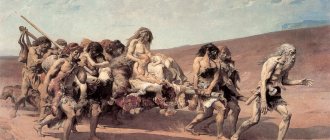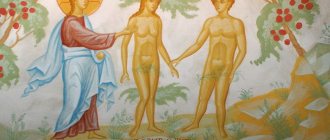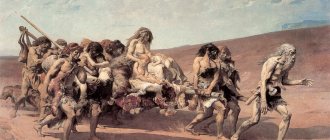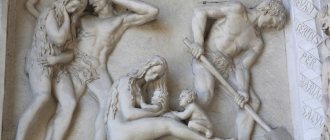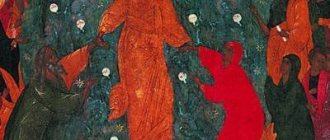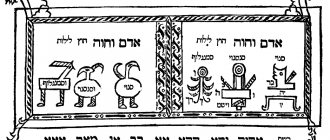Sri Lanka is a very unusual country. Until recently, little was known about it, and the only association, of course, was the famous Ceylon tea. The English colonists grew tea on an island in the Indian Ocean. That's all. However, this is not all. The country's island position has made it possible to keep many secrets intact. And if you take a closer look at the history of Sri Lanka, it turns out that this small state had a considerable influence on its neighbors, the countries of Southeast Asia.
Specific difficulties
— Father Alexander, is it true that biblical archeology exists in order to confirm the truth of the Holy Scriptures?
— I would place emphasis differently. Not to “confirm the truth,” but to restore the historical and cultural context of the events described in Scripture. I would like to emphasize that biblical archeology is a science, it is a certain specialization within archeology as such, and therefore uses the same research methods, the same criteria.
Once upon a time, at the very dawn of biblical archeology, it was really believed that its business was the search for sacred relics, artifacts confirming the authenticity of the events of Sacred history. But this romantic era has long passed, and now even the term “biblical archeology” itself is rarely used - they usually talk about Syro-Palestinian archeology, about the archeology of the Levant (i.e., the Mediterranean coast of the Middle East) ...
In general, over approximately one hundred and fifty years of its existence, biblical archeology has made many discoveries that confirm the authenticity of the Holy Scriptures. More precisely, it turned out that the biblical narrative in its historical, cultural, ethnographic, and natural aspects is quite consistent with archaeological data. As for miracles, archeology (like any other science) can neither confirm nor refute them. This is the area of faith.
— How do biblical archaeologists generally work? Are they directly involved in excavations?
— They do, but not always. Moreover, it is impossible to dig everywhere. For example, in Israel alone there are about two thousand excavations being carried out simultaneously, and yet the area of interest of biblical archeology is not limited to Israel - it is the entire Mediterranean region, Mesopotamia, and Egypt. Therefore, biblical archaeologists primarily engage in the analysis of field data.
I think it’s worth explaining how archaeological research is generally conducted. It all starts with reconnaissance: assumptions are made, samples are taken to determine whether it is worth digging in this place at all. The second stage is the excavation itself. The territory is mapped, divided into squares of 5x5 m. Then the excavation process itself begins: layers are removed literally a few centimeters a day. The position of each item found is recorded, all ceramics, all pieces and fragments are processed. This is very slow work, dragging on for years. The third stage is a description of what was found: at what level it was found, what layer it is associated with, how it can be dated. And finally, the fourth stage is analytics, desk work. The mass of materials obtained through these excavations needs to be tied together and built into a picture of the history of the ancient world.
—Are there any specific difficulties in the work of biblical archaeologists?
- Well, of course there is. This is especially true for the excavation stage. It is generally dangerous to dig in the Holy Land - the environment is very tense. I know this personally, because I participated in several expeditions. The local population can throw stones, and therefore security is definitely needed there. There are various provocations - for example, in one of the expeditions in which I participated, local residents threw a doll with a noose around the neck to the archaeologists. Quite a clear hint. But the threat comes not only from the Arabs, but also from Orthodox Jews, who consider excavations to be a deeply vicious and blasphemous activity. Local Arabs are simply unhappy that someone was digging something under their houses, on their territory.
There are also difficulties of a completely different order - many researchers are simply afraid to give their findings any religious interpretation. This is especially true for scientists from the United States: they do not want to be branded as retrogrades in the American academic environment, which is quite atheistic (which, by the way, is very different from American society as a whole, where more than 50% of the population regularly participates in church services).
usage
Humanity - man - male personality
The Bible uses the word אָדָם ( 'Adam
) in all senses: collectively ("mankind", Genesis 1:27), individually ("man", Genesis 2:7), gender-non-specific ("man and woman", Genesis 5:1-2) and masculine (Genesis 2: 23–24).[7] In Genesis 1:27, "adam" is used in a collective sense, and the interaction between the individual "Adam" and the collective "mankind" is a major literary component of the events that take place in the Garden of Eden, ambiguous meanings embedded in all the moral, sexual, and spiritual terms of the narrative. reflecting the complexity of the human condition.[12] Genesis 2:7 is the first verse in which "Adam" takes on the meaning of an individual man (the first man), and there is no context of sex; the gender distinction of "adam" is then repeated in Genesis 5:1-2, defining "male and female".[7]
Ground connection
A recurring literary motif is the connection between Adam and the earth ( Adama
): God creates Adam by molding him from clay in the final stages of the creation narrative. After losing his innocence, God curses Adam and the earth as punishment for his disobedience. Adam and humanity are cursed to die and return to the earth (or earth) from which he was created.[13] This "earthly" aspect is integral to Adam's identity, and Adam's curse of alienation from the earth seems to describe the divided nature of humanity—earthly, but separated from nature.[13] God himself, who took dust from all four corners of the earth of every color (red, black, white and green), then created Adam from them,[14] where the soul of Adam is the image of God.[15]
General value system
—What might be the advantages of biblical archeology compared to conventional archaeology?
— First of all, biblical archeology, when interpreting finds, relies on the text of Holy Scripture, and this allows it to give very reliable interpretations.
The point is this: we draw the bulk of information about the life of this or that ancient people from their writing. If there is no written language - as, for example, in the case of the Dyakovo Finno-Ugric culture, which existed before the arrival of the Slavs on the territory of Moscow, then we can learn little about his life. We can roughly imagine life, the economy, and roughly reconstruct religious views based on idols and burials - but that’s all. But we will never know how people lived, what they thought about themselves and the world around them, what their religion and epic were.
Therefore, to ignore texts when interpreting finds means making a serious methodological mistake (and in modern archeology there are areas that underestimate the role of written evidence).
The Holy Scriptures are a most valuable source for historians and archaeologists. After all, this is not one book, but a whole corpus of texts created over more than a thousand years. Therefore, many unbelieving archaeologists try to correlate their data with the text of the Bible.
Yes, there is a reason for controversy, yes, there may be different interpretations of certain points. Well, for example, let’s take the question of the emergence of monotheism. Did it arise gradually, in an evolutionary way, or is it the result of Divine revelation? The artifacts found show us how the worldview of the Jewish people changed over the centuries. Let's say, in the 7th-8th centuries BC, kings Hezekiah and Josiah carried out religious reforms (which we know from the text of Holy Scripture), and we see traces of these reforms - destroyed altars, destroyed figurines of idols. But two silver scrolls found in Jerusalem in the Gehenna Valley, containing a text very close to the priestly blessing from the book of Leviticus, date back to the same time. This means that at the same time both the pagan tradition and monotheism existed and opposed each other. And here archaeological data can be used to show the logical failures in atheistic concepts that claim that monotheism originated from the worship of the ancestral god of one of the Semitic tribes.
— Many scientists involved in biblical archeology are believers. Does their religiosity somehow affect their scientific work?
- Let's clarify what we mean. The question can be understood this way: aren’t religious researchers retreating from scientific objectivity and impartiality, aren’t they falsifying data to suit their worldview? If we are talking about this, then I will say right away: no. Archeology, including biblical archeology, is a science, and like any science, it is difficult to “cut corners” and not get caught. All data can be double-checked, all publications are publicly available and can be criticized. So if there were unscrupulous scientists from among the believers, they would have been grabbed by the hand long ago.
But your question can be put differently: does religious faith help biblical archaeologists in their work? And here I am ready to assert that a believing scientist has a serious advantage compared to an unbeliever: we believers have much more in common with the people whose lives we study. For us, as for them, questions of the existence of God are the main questions of life. We share a common value system with them. Abraham, Isaac and Jacob, kings David and Solomon, the apostles Peter and Paul lived thousands of years ago, but we are spiritually close to them. Therefore, we understand much more clearly their motivations, their life goals, their ways of making decisions. Consequently, when we are faced with the task of interpreting the results of archaeological finds, reconstructing the life of the ancient Jews, it is easier for us to do this than for unbelieving scientists, for whom religion is something alien and incomprehensible. This misunderstanding, by the way, often causes non-believing archaeologists to make mistakes in interpreting finds.
Source
And Elohim Created Adam
, William Blake
Most scholars believe that the book of Genesis dates back to the Persian period (5th-4th centuries BC),[9] but the otherwise absent Hebrew Bible of all other characters and incidents mentioned in chapters 1–11 of Genesis (Adam appears only in chapters 1–5, except for a mention at the beginning of Chronicles where, as in Genesis, he heads the list of Israel's ancestors[10]) has led a significant minority to conclude that Genesis 1–11 was written much later, perhaps in III century BC.[11]
Much ado about nothing
— Do biblical archaeologists often make mistakes in general?
— Errors in scientific activity are inevitable, and moreover, they are even strategically useful, since their discovery leads not only to a revision of some specific views, but also to a deeper understanding of the problem.
Errors can be divided into two groups. Firstly, these are errors associated with incorrect interpretation of the text of Holy Scripture, and secondly, errors of an archaeological order: incorrect descriptions of artifacts, incorrect dating of what was found, and so on.
Priests at the excavations - Priest Alexander Timofeev (right), Archpriest Georgy Urbanovich, rector of the Smolensk Seminary (left), and Abbot Moses (Pilatz), rector of the monastery in Alapaevsk (top)
Here is an example of an error of both the first and second types. The famous Israeli archaeologist Yigal Yadin conducted many years of excavations in Megiddo, Hazor and Gezer and found the remains of multi-chamber gates everywhere. Before him, it was believed that in Gezer, for example, this was not a gate, but the remains of a tower. Yadin proved that these were the entrance gates of the city and unambiguously correlated them with the royal cities mentioned in the 3rd book of Kings, which Solomon built. He suggested that all these gates date back to the 10th century BC. But further research showed that all these gates were erected at different times. In Hazor, it is really the 10th century, in the rest - later. Yadin's scientific opponents even stated that there was no unified kingdom of David and Solomon at all. Yadin's mistake was that he so clearly connected the gate he found with the gate mentioned in the book of Kings. But the Holy Scriptures do not say at all that Solomon made this gate royal. They could have been built later, they could have been rebuilt many times. Yadin's mistake stems from an insufficiently accurate interpretation of the text of the Holy Scriptures and insufficient (and this is quite natural for his time) possibilities for accurate dating.
— The example you gave is still a particularity. Were there such serious, “systemic” errors that it was time to doubt the reliability of the results of biblical archeology and the authenticity of the biblical narrative?
— There were no such mistakes. On the contrary, a whole series of discoveries convinces us of the authenticity of Holy Scripture. Biblical criticism of the 19th century, when it was believed that the Gospels were written at the end of the 2nd century by people who could not see Jesus, has become a hopeless past. Or that the history of the Old Testament was written after the captivity in the Hellenistic period. Now any archaeological scientist, regardless of personal attitude to religion, will confirm that the Gospel is a product of the era of the first century, that the first Gospels (Matthew, Mark, Luke) were written even before the destruction of the Jerusalem temple in 70 AD .that the authors actually lived in Jerusalem. This follows from many details, sometimes even reservations in the text.
— Do biblical archaeologists have to deal with fake artifacts?
- Yes, from time to time it happens. Forgeries began at the dawn of biblical archeology, in the 19th century. The most famous forger of that time was Moses Shapiro. He made and sold not even individual fakes, but a whole complex of artifacts. These artifacts were bought by famous museums around the world - today Shapiro’s handicrafts can be found in the British Museum, the Louvre, and the Hermitage. I myself had to hold these fakes in my hands. For example, he cut off a part from an ancient scroll and put new inscriptions on it. As a result, Shapiro was exposed by the famous scientist C. Clermont-Ganneau, he was threatened with judicial investigation and he committed suicide.
But it is not always possible to clearly identify a fake. For example, in 1997, an Israeli collector presented to the scientific community an ossuary with the inscription “James, son of Joseph, brother of Jesus.” An ossuary is a box where bones were placed after the body had decayed. The ossuary itself is undoubtedly authentic, but there is some debate about the inscription. There was an uproar and there was a colossal trial. As a result, a decision was made: the court does not have data either for or against the signature. Therefore, the accused are free. But the question of authenticity still remains open.
Jerusalem was destroyed several times. And so there are historical difficulties in reconstructing houses and buildings from the time of Christ. The first destruction occurred in 70, when the Romans literally left no stone unturned. After this, several more cataclysms followed: the construction of the Roman city of Aelia Capitolina, the capture by the Persians in 614, then reconstruction by the Arabs and crusaders...
— How can ordinary people, non-specialists, perceive regular sensations on the topic of archaeological finds that supposedly overturn all our ideas about the Bible?
- You need to be extremely careful. First of all, you need to understand that journalists, as a rule, are not very educated people and therefore can be sincerely mistaken, considering something a sensation. Here is an example - a recent discovery that caused a lot of noise, the “gospel” of Judas. This is not a forgery, this is truly an ancient text - but a text created by the Gnostics in the 2nd century AD. Moreover, this text has long been known to the Church; the Hieromartyr Irenaeus of Lyons mentions it when he describes various Gnostic sects. The discovery of the “gospel” of Judas even benefited science: it became clear that the Gnostics were developing their own religion, completely different from either Judaism or Christianity. From Christianity there was only terminology. In a word, this text did not change anything, it was known, but when the Gnostics died out, it was forgotten.
But there are also obvious fakes; their creators strive only for fame and money. The press begins to promote such fakes.
Here's something else you need to understand: no serious researcher will ever contact the yellow press. Even if he is in conflict with official science, even if he believes that he is being erased, his discoveries are not recognized, he still will not get involved with the tabloids. Therefore, if you read in the yellow press about a sensational discovery and see links to scientists allegedly confirming it, do not believe it. There must be some kind of fraud here.
In addition, take into account the fact that archeology is a slow science. From the discovery to its correct interpretation, many years, or even decades, often pass. Therefore, if they tell you that something has just been discovered, and this something is such and such (for example, the ring of King Solomon or the Gospel of Pontius Pilate, or the skull of Adam) - doubt it. Such a quick interpretation is simply impossible.
After the creation of the world, God created the first people - Adam and Eve
After the creation of the world, God created the first people - Adam and Eve. They lived in paradise, God allowed them to live as they wanted, eat, drink, live in peace and quiet.
But there was only one prohibition, God forbade them to eat the fruits of only one tree.
One day Eve was tempted by the devil, and she disobeyed the commands of God and ate fruit from the very tree from which it was forbidden to eat fruit. After which she gave this fruit to Adam, and he also tasted it.
Adam and Eve in Paradise. Over time, they had two sons - Cain and Abel
Then the first fall of people took place. God expelled Adam and Eve from paradise because they disobeyed His commands.
He expelled them from paradise, and Adam and Eve began to live on earth. They cultivated the land, engaged in livestock farming and other labor, hoping that God would forgive them and return them to the Kingdom of Heaven.
After the Fall, God expelled Adam and Eve from paradise and they began to live on earth
Over time, they had two sons - Cain and Abel. Abel and his brother Cain, just like their parents, tried to please God in everything and lived according to God’s commandments.
Abel was engaged in cattle breeding, and Cain grew plants. They very often brought their sacrifices to God, trying to appease and receive mercy.
Cain lit a fire, throwing fresh ears of corn into it, taken from his harvest, and Abel sacrificed a lamb to God. The Lord saw that Abel made a sincere sacrifice, but Cain did not.
Therefore, God accepted a sincere sacrifice, but ignored Cain’s sacrifice.
Cain and Abel make a sacrifice to God. Cain lit a fire, throwing fresh ears of corn into it, taken from his harvest, and Abel sacrificed a lamb to God
Then Cain became very angry with his brother. Every day he hated Abel more and more, anger grew more and more in his heart.
Then Cain killed Abel, calling him to the field with him.
When the Lord saw this, he asked Cain where his brother was. And he answered him that he did not know. Any murder is a sin, and shedding the blood of a loved one is doubly bloody.
Cain lost his mind so much that the thought of killing his loved one, his brother, arose in his head.
Archeology as a kind of pilgrimage
— In the church environment, you can sometimes hear the opinion that the Church does not need biblical archeology at all. We have Scripture, we have the Holy Fathers - and what more do we need? Have you ever heard something like this?
- Yes. For example, I encountered such prejudice among students at theological seminary. They, not yet knowing the content of the course, say that science is not needed, there is no need for scientific study of the Holy Scriptures, it is enough to just read it.
This is actually a serious mistake. The point is that just reading is not enough. You also need to understand, and moreover, be able to relate what you read to your current life. And for this you need to know the context of the events described in the Bible.
We, modern people, for the most part do not know this context. Therefore, while reading, we skim over the surface; the text does not touch us, but it does not touch us precisely because the background of the events taking place is incomprehensible to us. Archeology helps restore this background. Here is a small example - in the Jewish version of the book of Kings (it is a little more detailed than the text of the Synodal translation) it is said that the Philistines monopolized the production of iron tools, and the Israelites had to pay them one “pim” for sharpening. What is Pim? When archaeologists found weights and weights with the word “pim” written on them, it turned out that pim of silver was a lot. That is, it turned out that the Jews paid very dearly, that the Philistines, having monopolized blacksmithing, kept them in the position of slaves. A small detail that gives an idea of the plight of the Israeli people at that time.
I give many popular lectures on biblical archeology outside of seminary. For example, at the Higher Theological Courses at the Moscow Academy of Arts, hundreds of people have already taken my course. What’s interesting is that after the first lecture, the attitude changes radically. Skepticism disappears. And this happens because there is a living feeling of the Old Testament and Gospel events. It arises precisely thanks to biblical archeology - it helps to get used to the subject.
In this sense, biblical archeology can be compared to a pilgrimage to holy places. A pilgrim who has walked in the footsteps of the Lord, in the footsteps of the apostles, who has felt the beating of the heart of history in these places, begins to have a completely different attitude towards the Holy Scriptures; it comes to life for him.
— What does biblical archeology mean to you personally? What does she give you?
— I can give you this example: I was preparing a monograph on the Apostle Paul. I walked the entire path of the Apostle Paul, described in the Acts of the Holy Apostles, several times, studied a lot of literature, museum collections... and I was very impressed by all of this. It’s one thing to simply know the New Testament text, and quite another to let it pass through you, walking this path, seeing the artifacts of that era. After this, you begin to have a different attitude towards the texts of the Apostle Paul - knowing to whom he writes, in what conditions.
Jordan. The place where Christ was baptized. Photo by Vladimir Eshtokin
Adam's ancestor, the righteous Noah, dug up his relics from the ground and took them with him to the ark.
Then Adam’s ancestor, Noah, dug his relics out of the ground and took them with him to the ark. After all, it was Noah who built the ark that the Lord commanded him. He took his family there and a pair of each creature.
After the flood, Noah distributed Adam's relics to each of his sons. But all this happened, if you believe numerous legends, perhaps much of this was simply made up.
The foundation of the tomb of the prophet Noah dates back to 1539 according to the encyclopedic dictionary of Brockhaus and Efron. Yerevan
There is also Noah's grave. One of them is located in the place where the body of Adam and Eve lies, the other grave is in Mecca. Noah's grave was also discovered on the soil of Azerbaijan.
Currently, the grave appears as a mausoleum since 2006. The tomb consists of two floors, on the lower floor there is a former temple.
Currently, Noah's grave looks like a mausoleum
They go down the stairs into the crypt. In the middle of the entire crypt there is a stone pillar; according to legend, it is above this pillar that the relics of Noah are located.
All these places attract a huge number of pilgrims, everyone wants to see and venerate the graves of Old Testament people.
By leaving a comment, you accept the user agreement
Man-animal
In the understanding of the Gnostics, the world was initially perfect, but then the evil Demiurge appeared and, imitating the Creator, began to create his own material universe, which violated the original harmony. The Demiurge also subjected Adam to a change, who turned into a bad copy of the divine creation - now he became a human animal, guided only by emotions and instincts.
The American existentialist philosopher Jonas Gans, interpreting the Gnostic idea, wrote that the seduction of Adam is “the evil intent of Darkness directed against the original. From now on, the struggle between Light and Darkness centers on man, who becomes the main prize and at the same time the main battlefield of the two fighting parties.” According to the Gnostics, Eve became the instrument for seducing Adam, who persuaded him to copulate and further reproduce. They call it "the biggest undertaking in Satan's strategy."
